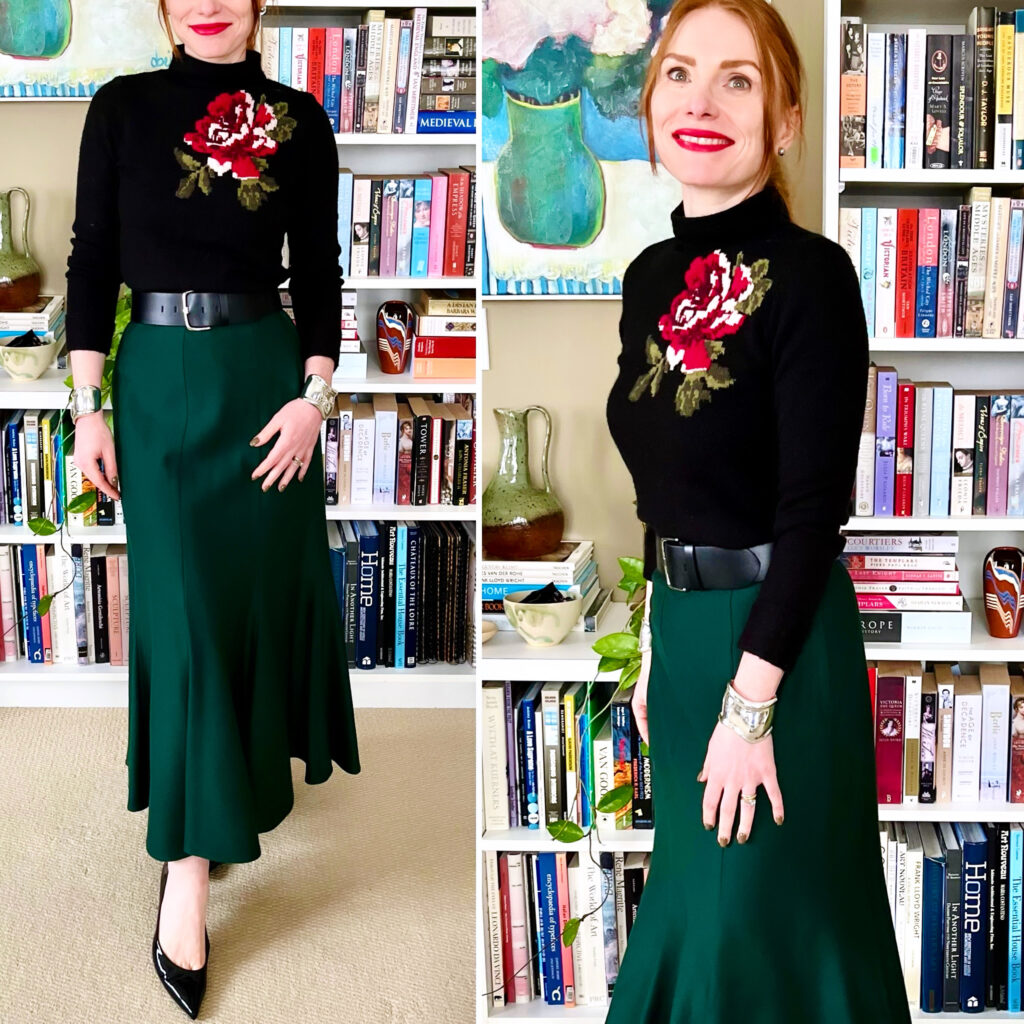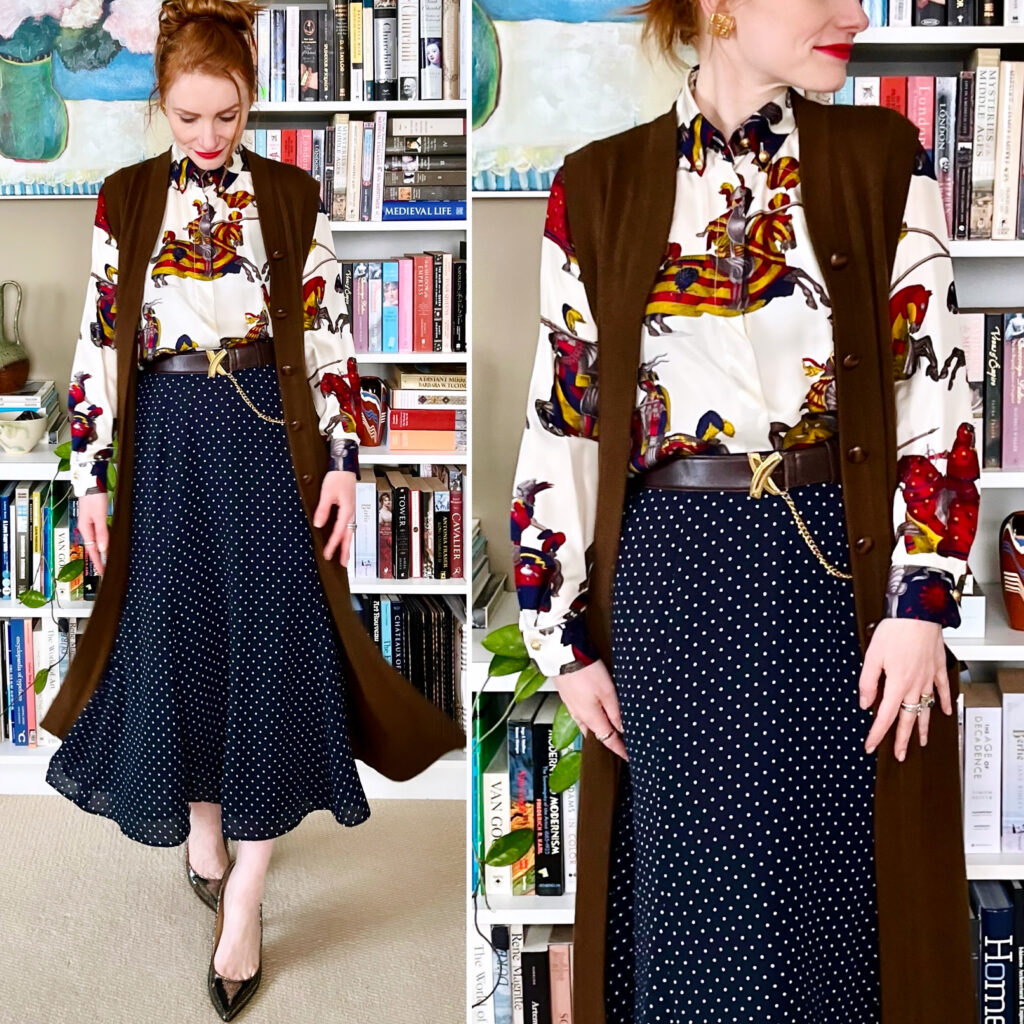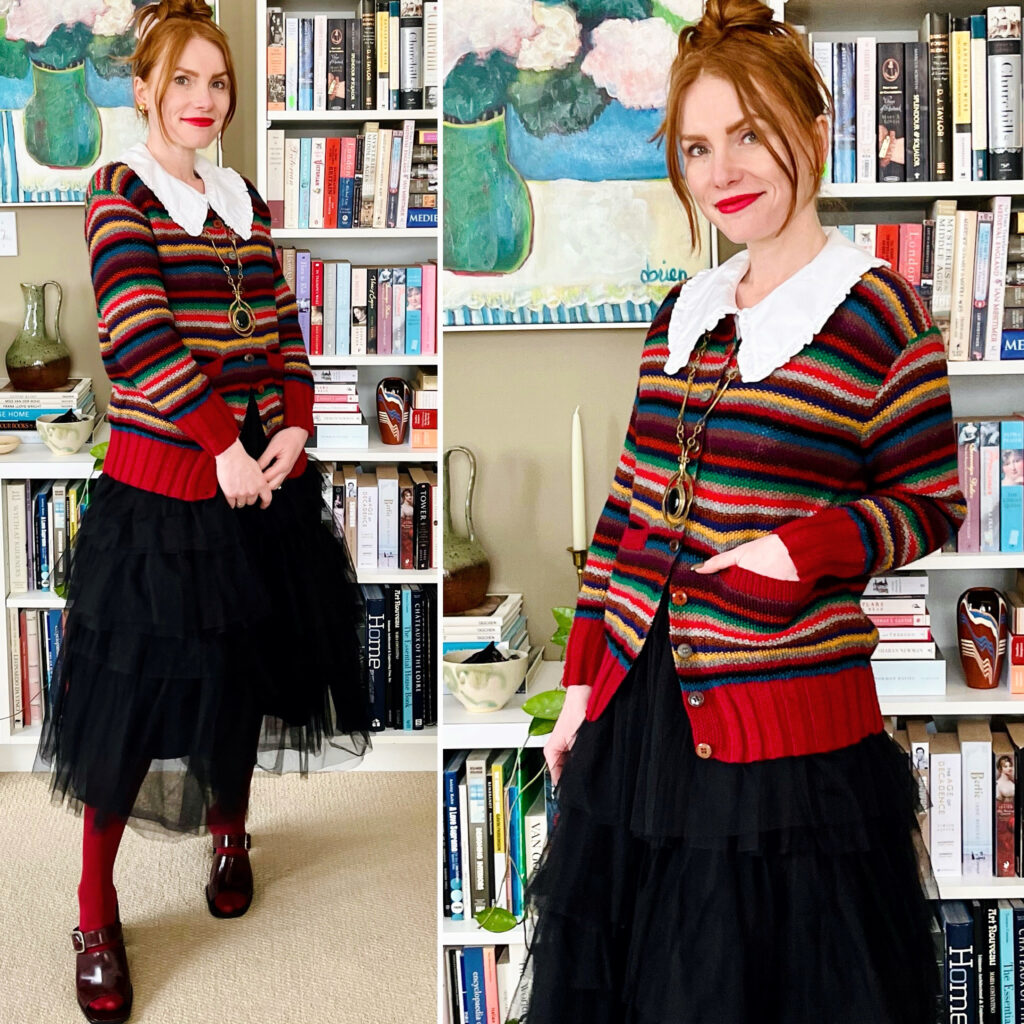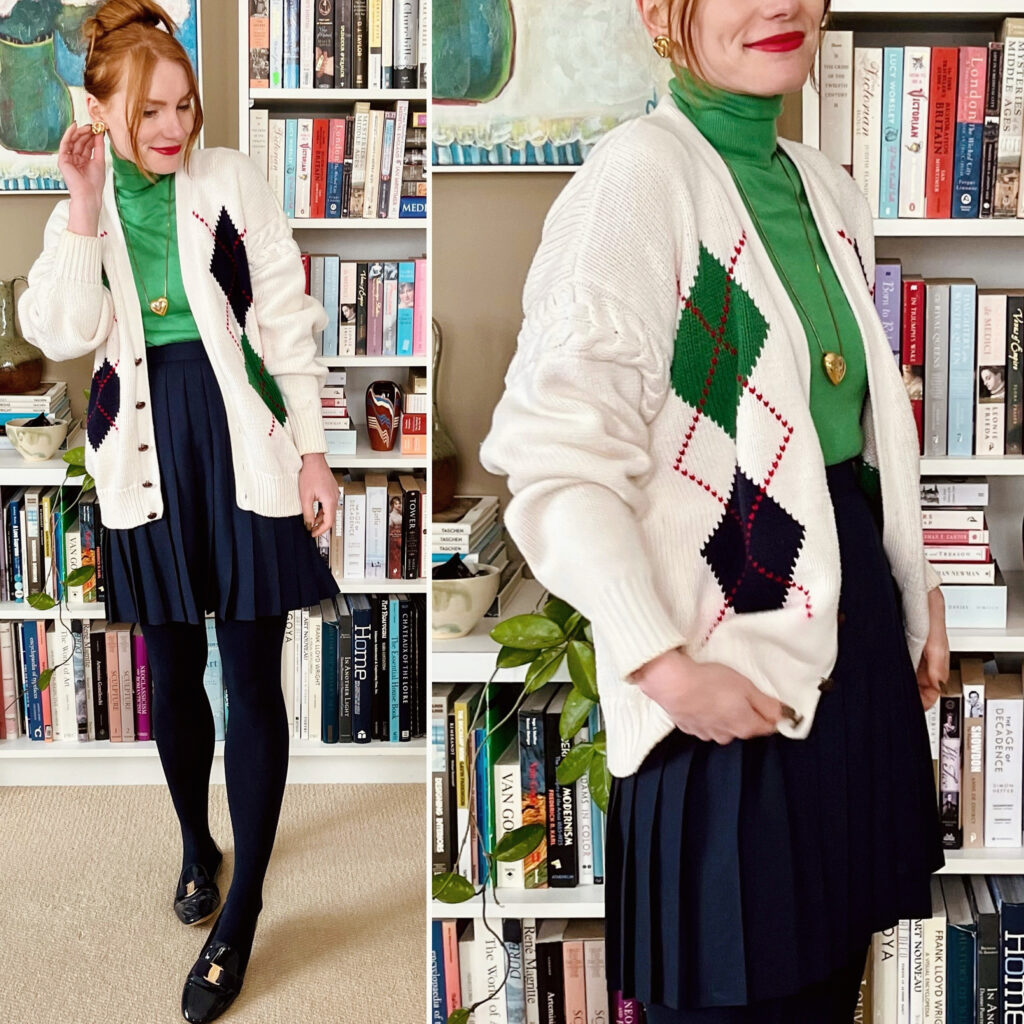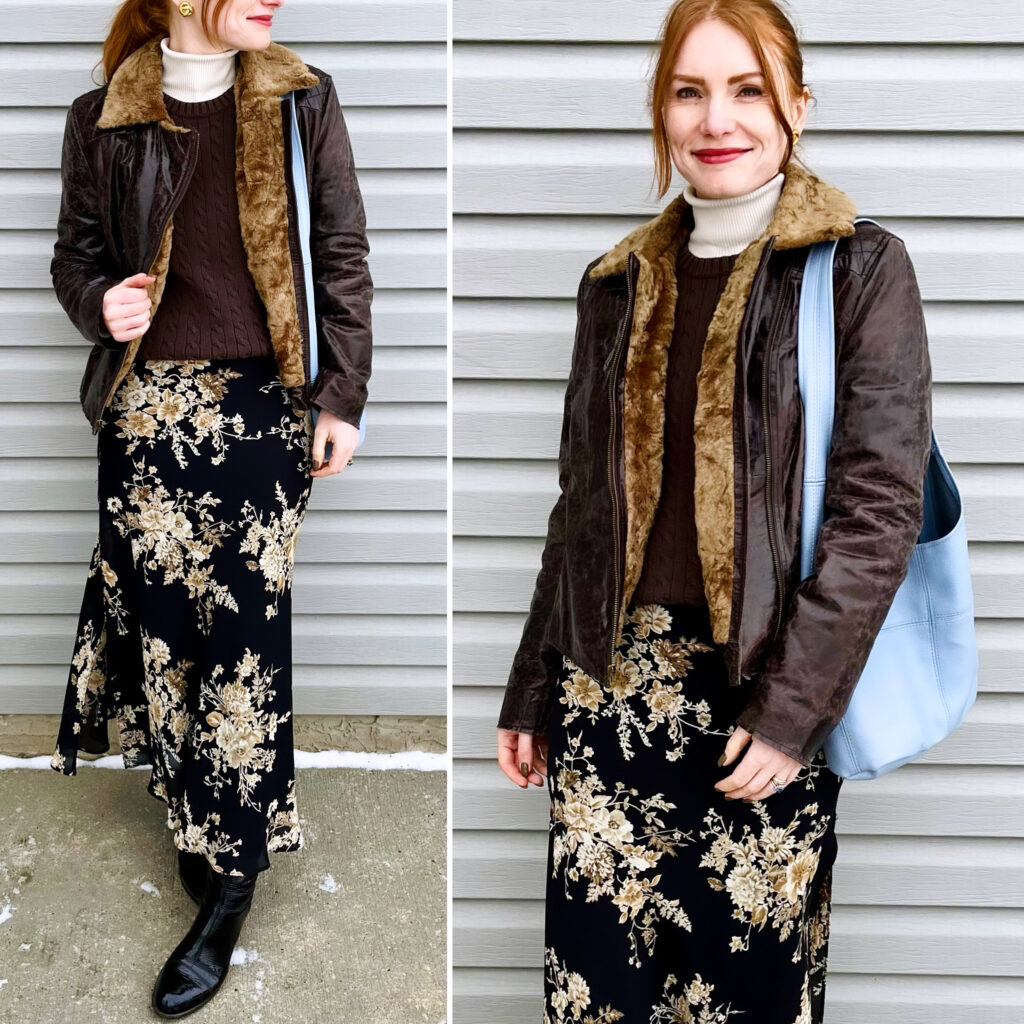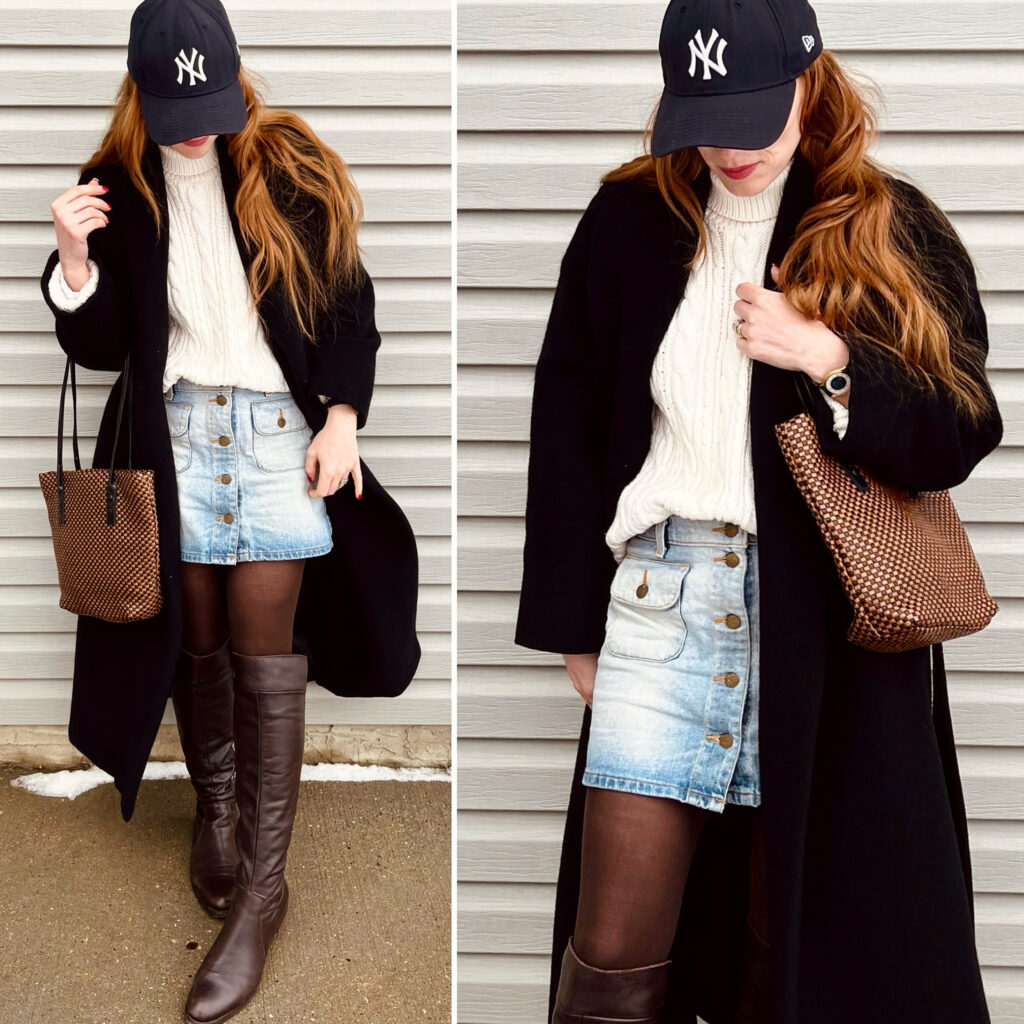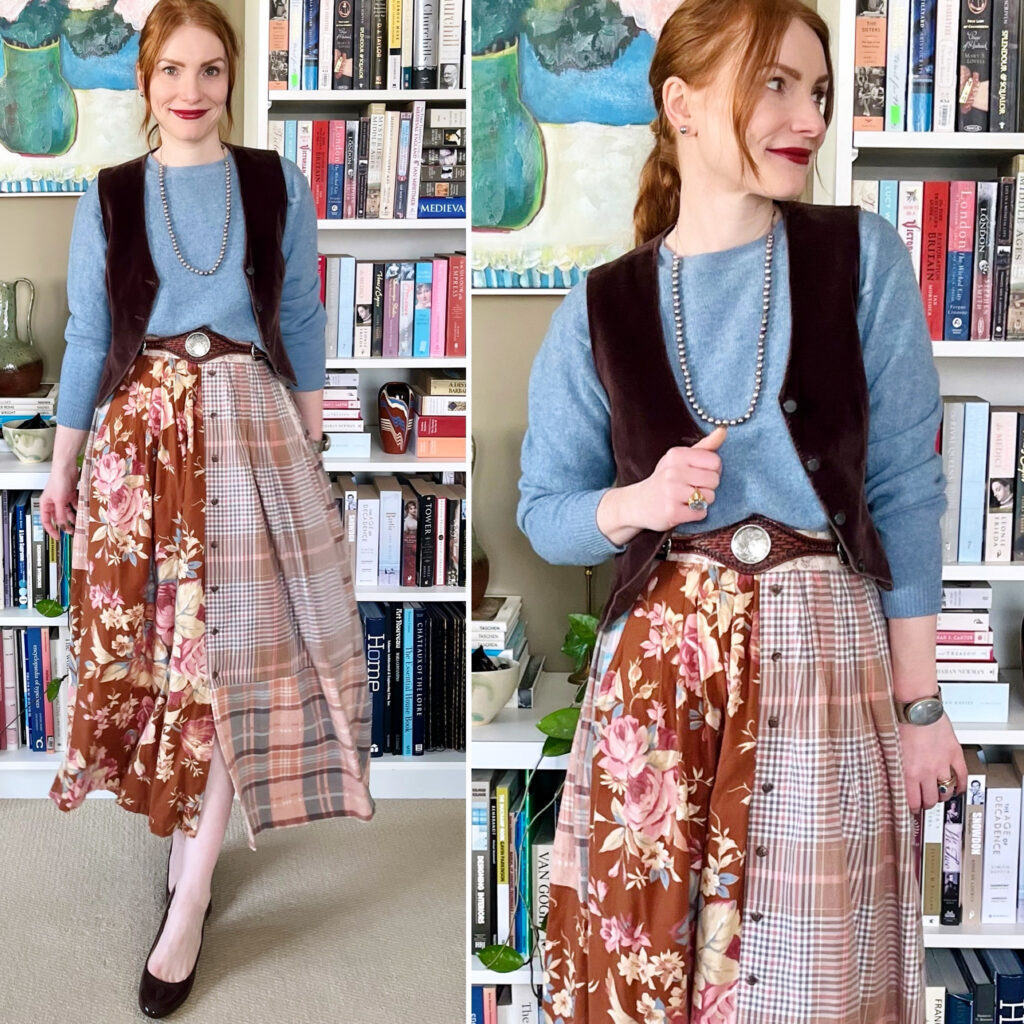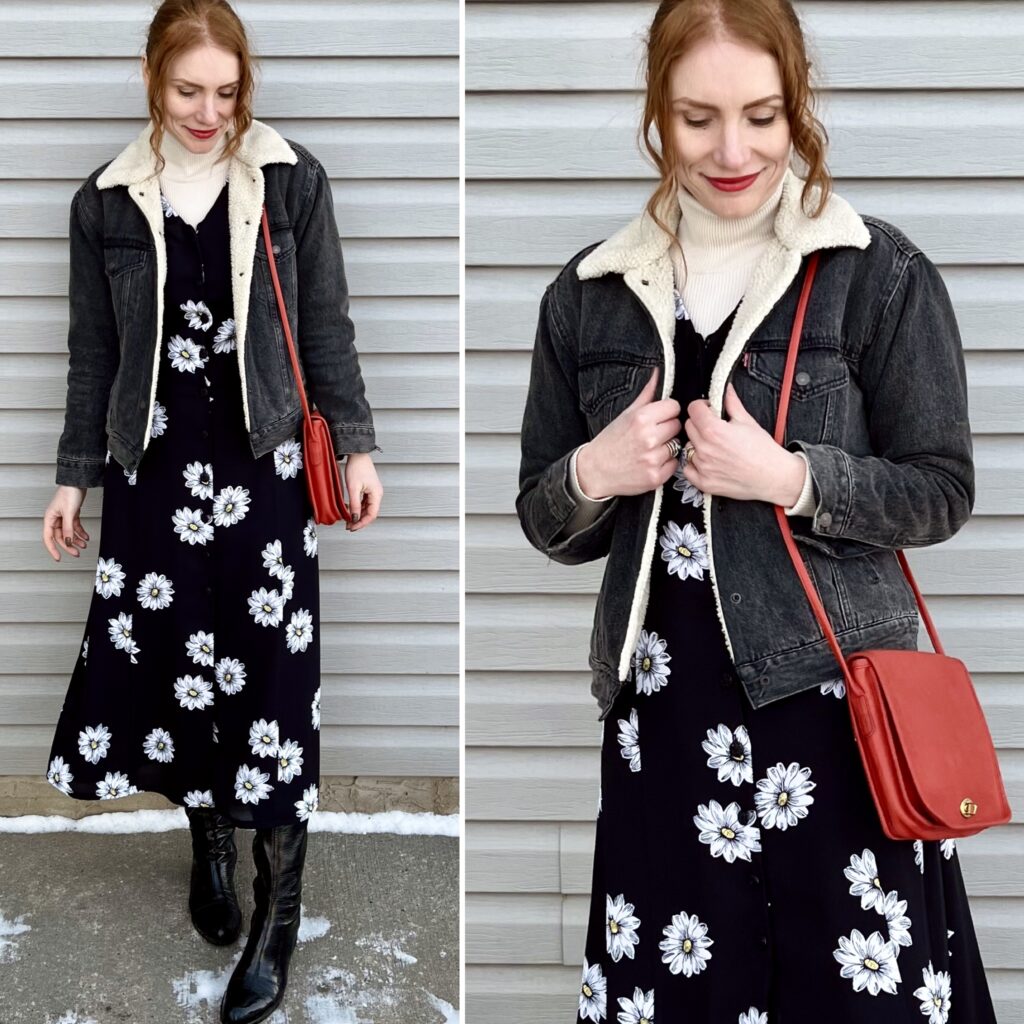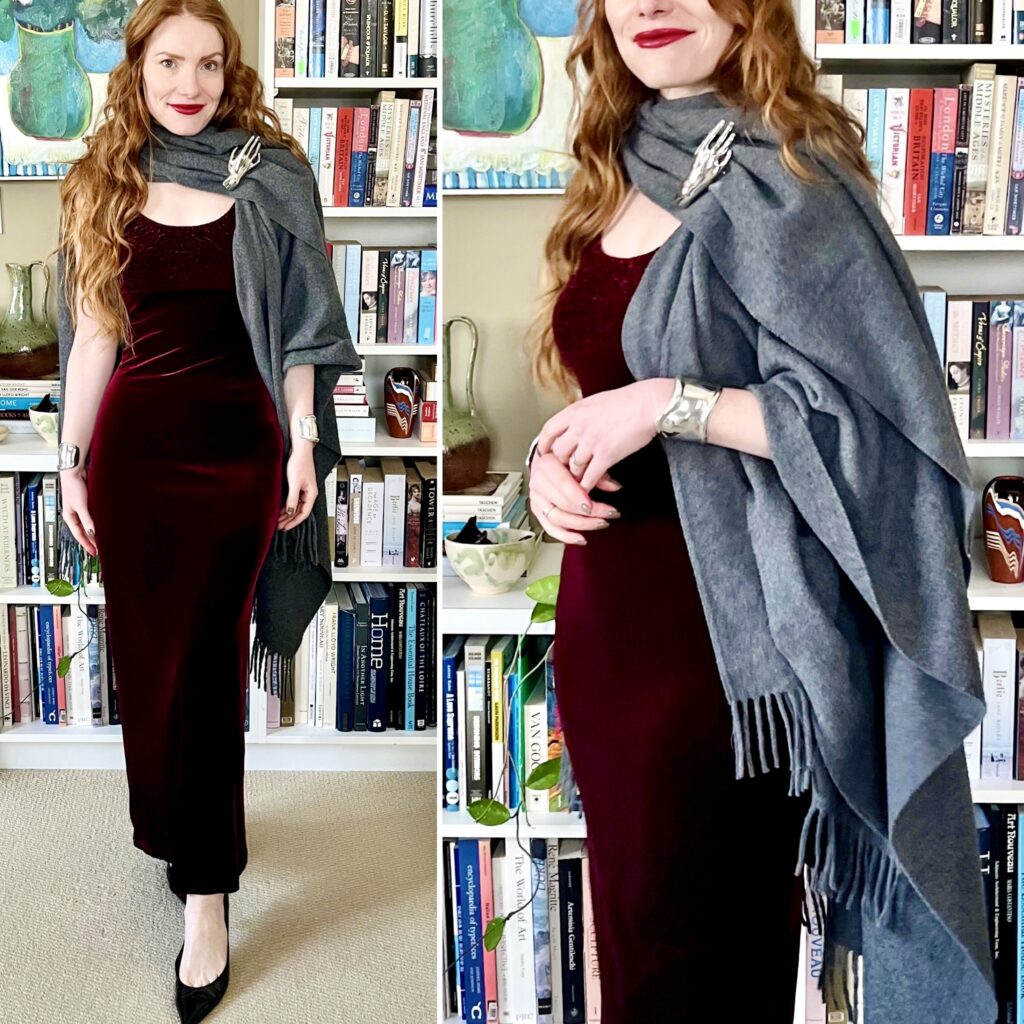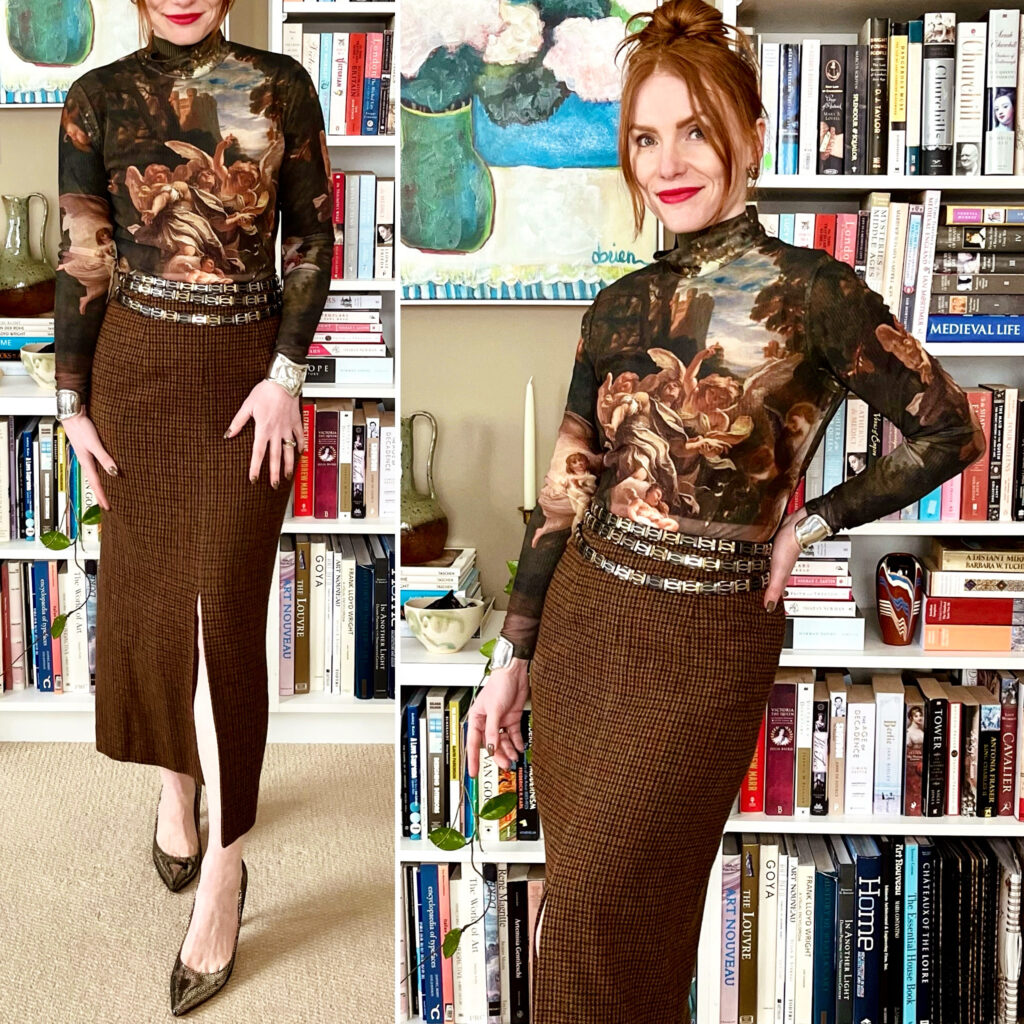
Details: unbranded mesh top, H&M turtleneck, Ralph Lauren skirt, vintage belt (all thrifted)
Thoughts: I love a baroque painting-inspired piece, so I snapped up this mesh top immediately — even though I’m 99.9% sure that it’s super-fast fashion. Mesh tops are one of the few items where quality doesn’t matter all that much; by their very nature, the material is going to be synthetic, and as I always wear them layered, that is somewhat inconsequential. I love this top, and so does my daughter, so we’re having fun and keeping something out of the landfill. Win-win. The other statement piece here is that belt, which is now officially one of, if not the coolest one I own. It’s vintage but has no stamping, so I have no idea what brand it is, but it delivers maximum style impact. Literally, an outfit maker. By the way, I am hearing that maxi skirts — both column and full styles — are trending for 2025. That on top of the resurgence of chocolate brown makes me feel like sartorial Christmas came early this year. Given how the rest of, well, everything is going right now, I’ll take small wins no matter how infinitessimal they are.

Details: unbranded cardigan, Gap turtleneck, Acne skirt, Suzy Shier coat (all thrifted), Tignanello bag (Poshmark)
Thoughts: I was super excited to find this looooooong wool Acne skirt for, like, $8 at Value Village, only to run into an immediate block. I had no idea how to style it. We have established how much I love column maxi skirts, but this one is extra long (like, seriously!) and the colour is not in my usual wheelhouse. I’m exploring grey this season, but I’m still in the early stages of figuring out how to incorporate it into my wardrobe palette. So, I kept the skirt to the side, waiting for inspiration to strike. Eventually, I decided to just go for it. And by “it”, I mean anything. Sometimes you gotta try something even if it’s not perfect, just to get the creative ball rolling. As it turned out, this outfit wasn’t half bad. I do love grey and yellow together, especially bookended with black, which makes them pop. I also learned that I have to roll the waist of the skirt a good 5 inches to make it wearable without stilts. This means that I can’t have the waist showing, so tucking in is a no go. That, in turn, puts certain parameters in place for the kinds of tops/sweaters I can wear with it. Outfit dominos, in action. So, now, I am further ahead in my exercise of figuring out how to style this dress. And I got a cute outfit out of it too.
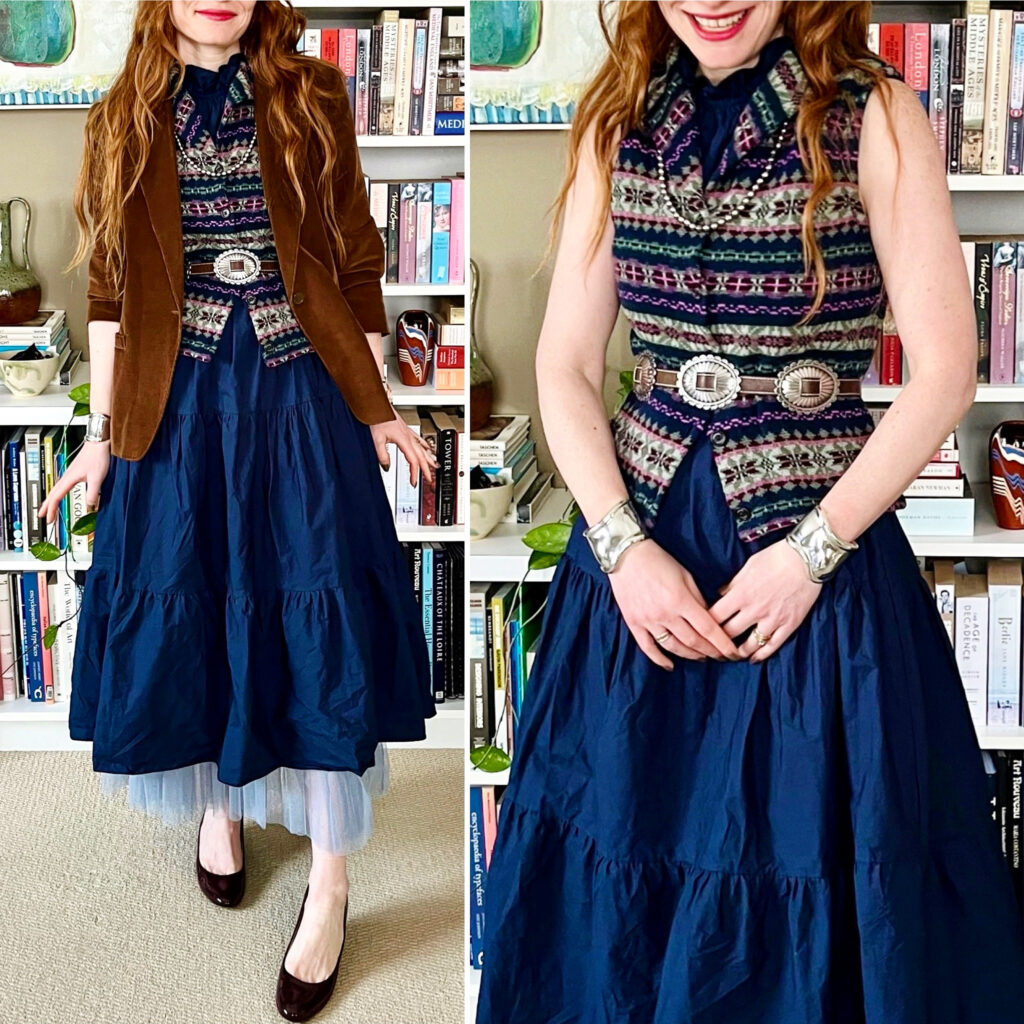
Details: Chepe dress (retail), Ports blazer, Ralph Lauren vest, Nocona belt, unbranded tulle skirt (all thrifted)
Thoughts: I jokingly called this my “invincible summer” outfit. IYKYK. While, sadly, that literary allusion currently doesn’t reflect my mental landscape, it always applies to my sartorial preferences; that is to say, no matter the season, I am always in the mood for summer clothing. Ergo, I am always looking for ways to wear my favourite summer pieces in their off-season. Layering is the main answer, obviously.

Details: Tahari shirt, H&M pants, Fossil belt, Ferragamo shoes (all thrifted), Ralph Lauren sweater (Poshmark)
Thoughts: I haven’t been as active on Poshmark in the last 6 months as before, but I still like to keep a hand — or, rather, an eye — in there for special things. That category includes vintage Ralph Lauren pieces to add to my archival collection. In this case, “archival” refers to the clothing itself — vintage items that encapsulate the brand’s history and aesthetic — rather than their function, because the plan is to wear the heck out of them. The Ralph Lauren brand is undergoing one of its periodic renaissances, having significantly shot up in popularity and trendiness in recent years; in tandem, and not coincidentally, the price of vintage RL clothing has gone through the roof. Keeping a steady eye on this market, I know how to spot a good bargain; they are increasingly rare. This sweater was one of them. It’s classic 90s Ralph, handknit, and I was able to score it for about 1/3 of the price of other listings. So, I jumped on it immediately … even though that meant buying it in the middle of the postal strike and sitting on tenterhooks for nearly a month, waiting to see if I’d end up getting it or if the seller would get fed up and cancel the purchase on me. Well, I’ve already spoiled the ending for you: I did eventually get it, and it was worth the wait. I know it’s a sweater I’ll treasure for years. And who knows … at the rate things are going, it might be an actual investment, hahahaha!

Details: Orvis shirt, Uniqlo sweater, Jones New York jacket, Eclat skirt, Banana Republic belt, Stuart Weitzman shoes (all thrifted), Land’s End bag (Poshmark)
Thoughts: I adore this sweater, and I adore this jacket, and that’s what this outfit is basically about. Oh, and the bag! This was the other Poshmark purchase I made this fall, and the second that ended up being stuck in transit during the strike. Again, worth the wait. As you know, I am obsessed with this shade of blue at the moment, and suede is still having its moment, so this bag checks off a lot of boxes. I was also intrigued by the shape; I haven’t worn hobo style bags for ages, but I’m finding myself drawn to them again. I actually found this bag by searching for a blue suede bag on Poshmark, and was surprised to end up with something from Land’s End of all brands — who knew they even made bags?? But the quality is great and for the price I paid ($40), I am very happy. Which also describes my feelings about this outfit. Top marks all around.
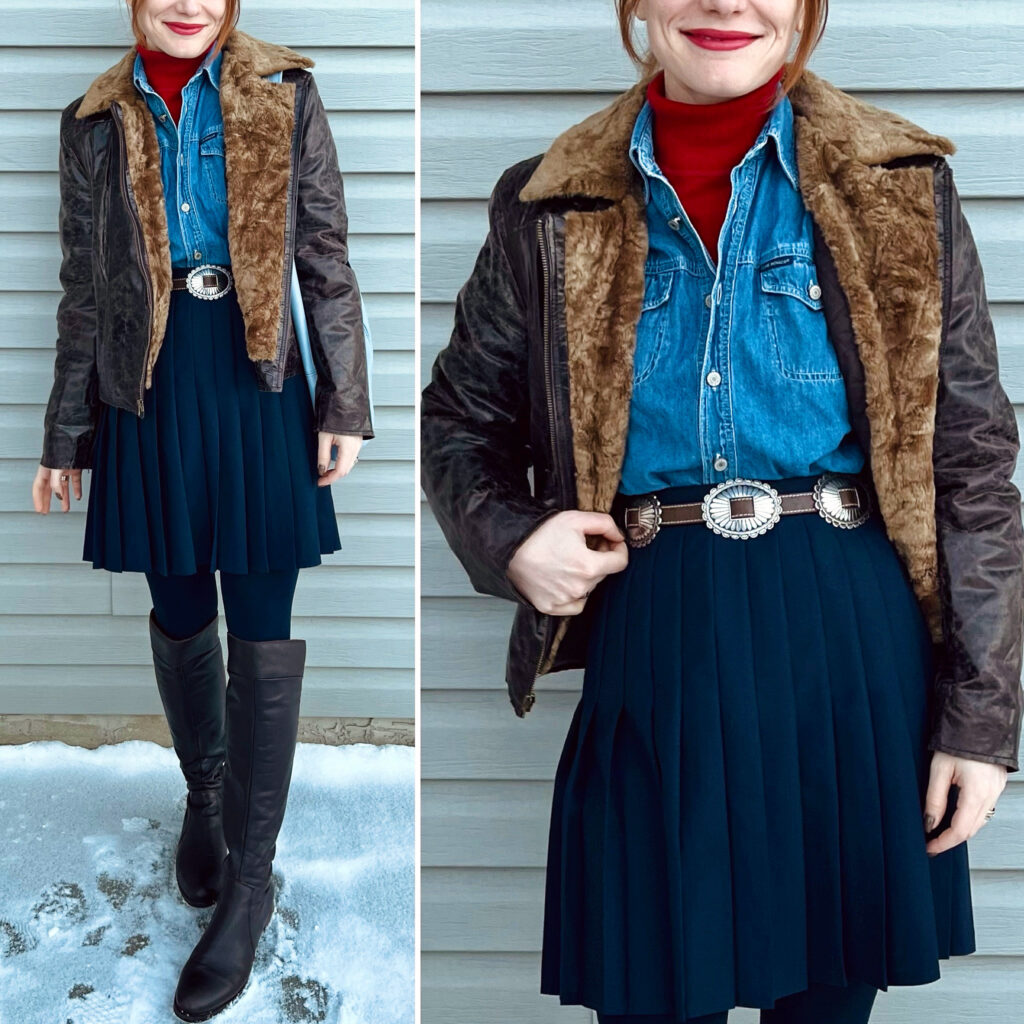
Details: Ralph Lauren turtleneck, Club Monaco shirt, Nine West jacket, vintage skirt, Nocona belt, Canadienne boots (all thrifted)
Thoughts: I straight up stole Papa Ralph’s personal style for the purposes of putting together this outfit, and I am not embarrassed at all. He’s the master of thoughtful layering, and I am forever in my seat, taking notes. Also, in case you were wondering, my experiments with mini-skirts are still going well.
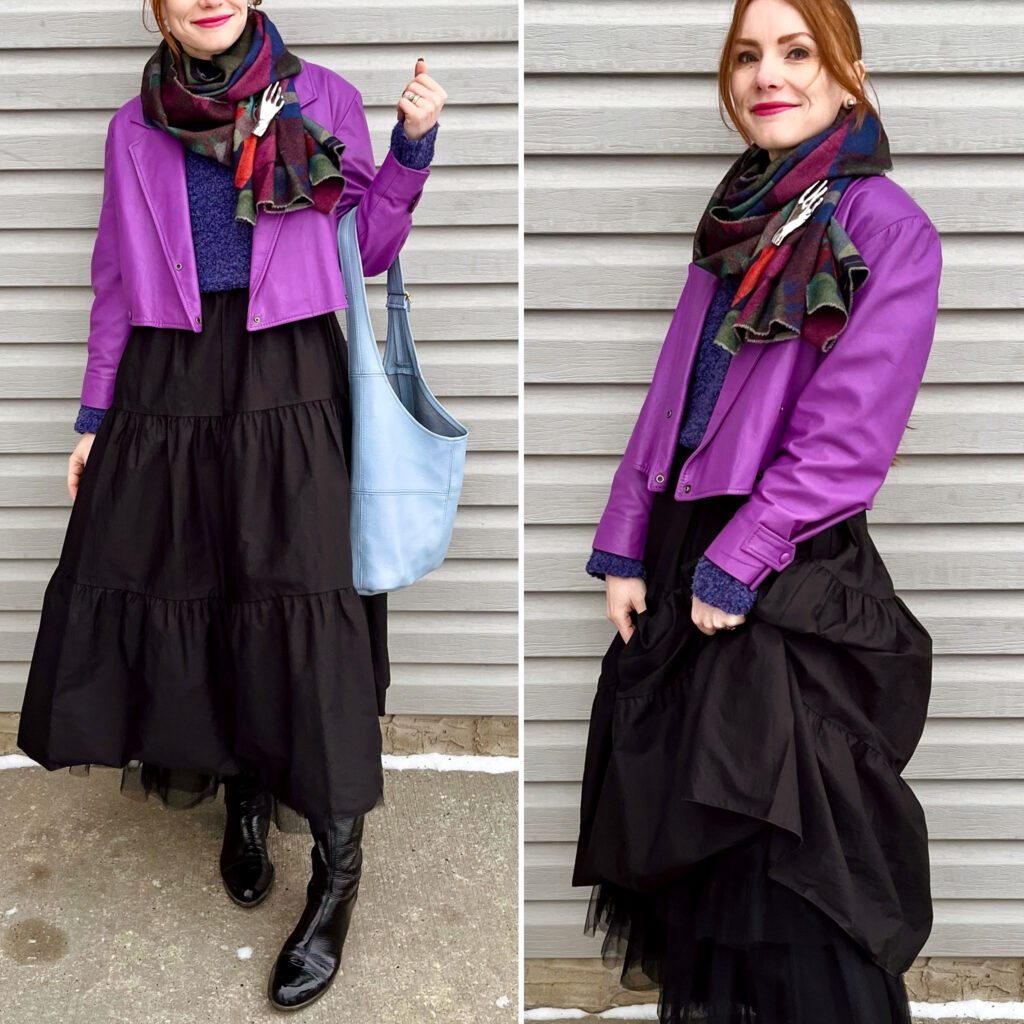
Details: Chepe dress (retail), Free People sweater, Paul Smith scarf, vintage jacket (all thrifted), Chicwish tulle skirt (Poshmark)
Thoughts: Here’s the same Chepe dress as above, in a different colour, winterized in a different way. But the underskirt is the key detail because what I’ve recently discovered is that tulle is perfect cold-weather insulation. Like, for real! As a bonus, it adds volume and creates interesting proportions. I had a bunch of different people compliment me on this outfit, including a small group of kids and a member of Gen Z. That kind of cross-generational appeal is something I’m definitely gonna brag about 😉





